| Author |
Message |
|
John Anthony
Location: FLORIDA Joined: 09 Nov 2010
Posts: 3
|
 Posted: Wed 10 Nov, 2010 8:17 am Post subject: Japanese Officer' samurai sword Posted: Wed 10 Nov, 2010 8:17 am Post subject: Japanese Officer' samurai sword |
 |
|
If there is carvings on both sides of the swords tag does that make the swords value higher than if there were no carving on the tag.
Who can i talk to to learn what these letters mean?
 Attachment: 158.4 KB Attachment: 158.4 KB
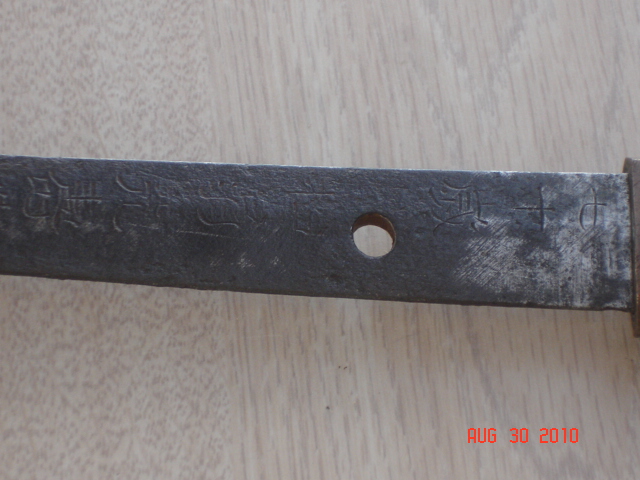
 Attachment: 131.78 KB Attachment: 131.78 KB
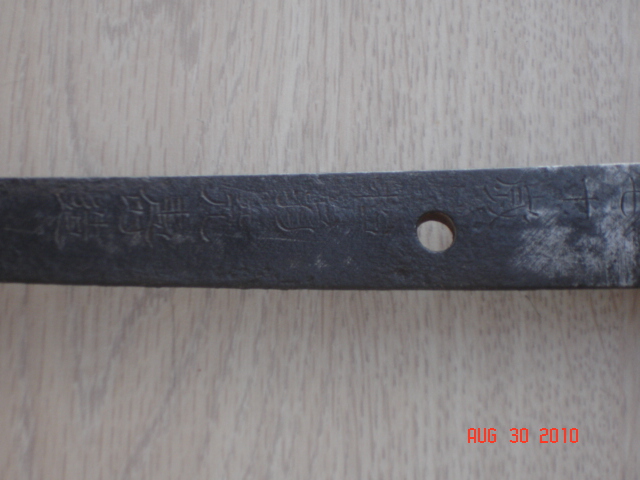
 Attachment: 153.43 KB Attachment: 153.43 KB
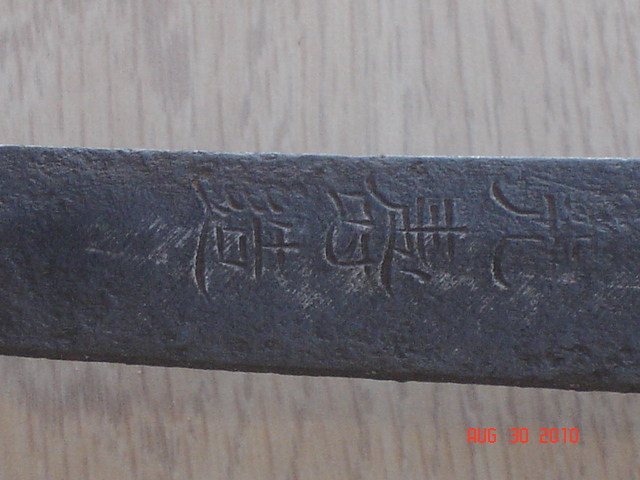
 Attachment: 148.59 KB Attachment: 148.59 KB

 Attachment: 113.95 KB Attachment: 113.95 KB
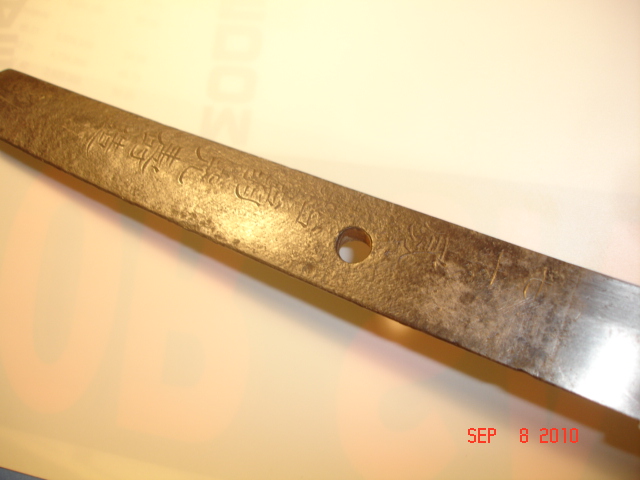
 Attachment: 109.42 KB Attachment: 109.42 KB

 Attachment: 114.75 KB Attachment: 114.75 KB
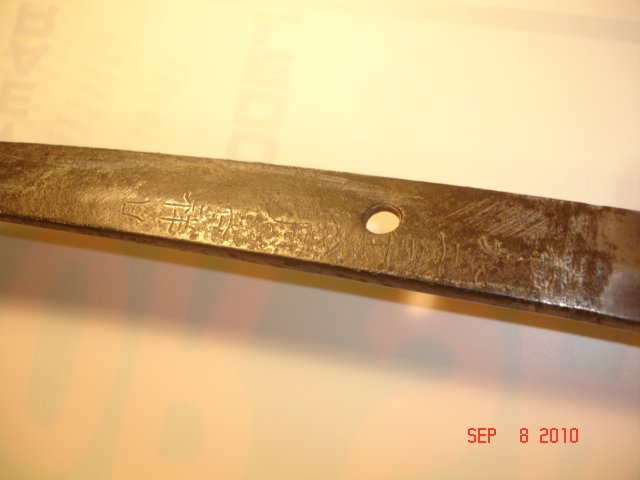
|
|
  |
 |
Ushio Kawana

|
 Posted: Wed 10 Nov, 2010 11:12 am Post subject: Posted: Wed 10 Nov, 2010 11:12 am Post subject: |
 |
|
Hi 
Unfortunately some your photos are indistinct... So I can't read... 
If you attachment clear photos of the letters, I may distinguish it... 
 Attachment: 27.94 KB Attachment: 27.94 KB
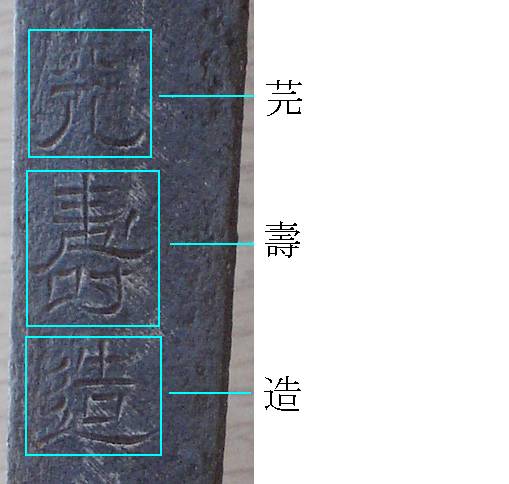
 Attachment: 27.35 KB Attachment: 27.35 KB
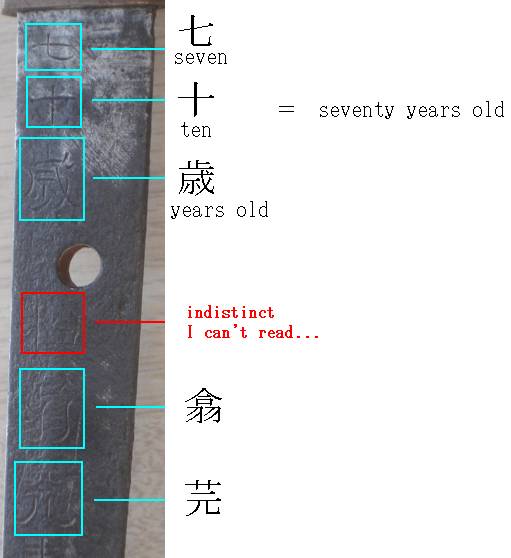
I'm interested in Medieval Arms and Armor.
But... My English is very poor ><;
|
|
  |
 |
Ushio Kawana

|
 Posted: Wed 10 Nov, 2010 8:45 pm Post subject: Posted: Wed 10 Nov, 2010 8:45 pm Post subject: |
 |
|
| Quote: | | Who can i talk to to learn what these letters mean? |
These letters are Japanese. So you should study Japanese.
English has the alphabet. And Japanese has a "hiragana", "katakana" and "kanji".
For example... An attachment image is tool-bar of IE(Japanese version).
It's displayed with [File] [Edit] [View] [Favorite] [Tools] [Help] with the English version.
It is difficult to study a foreign language...   
I study English as a foreign language, too. 
 Attachment: 10.04 KB Attachment: 10.04 KB
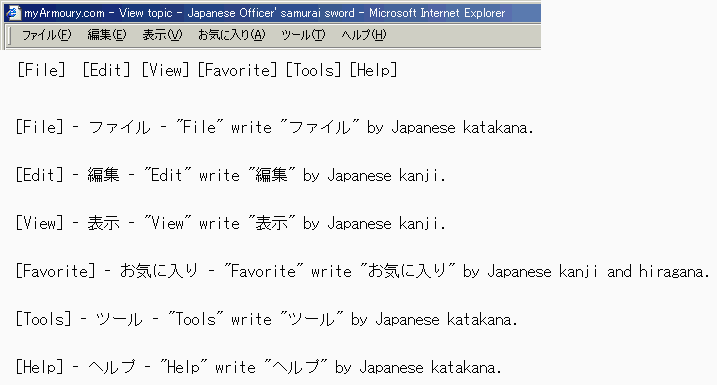
I'm interested in Medieval Arms and Armor.
But... My English is very poor ><;
|
|
  |
 |
Ushio Kawana

|
 Posted: Fri 12 Nov, 2010 2:08 am Post subject: Posted: Fri 12 Nov, 2010 2:08 am Post subject: |
 |
|
Hi 
John mailed some phtos to me.
And I was able to read the letters of the other side. 
It's mean "An August, 1849 excellent luck".
Kaei was a Japanese era name... http://en.wikipedia.org/wiki/Kaei
I was able to read the letters of the other side.
It's mean "Seventy years old (family name) Toshizou" The family name was not readable to me. 
These kanji is old kanji. So it is hard to distinguish it... 
It is written as "An August, 1849 excellent luck" on the front(back) side.
And it is written as "Seventy years old (family name) Toshizou" on the back(front) side.
This sword may be memory of the birthday. 
thanks 
 Attachment: 61.06 KB Attachment: 61.06 KB

 Attachment: 42.19 KB Attachment: 42.19 KB
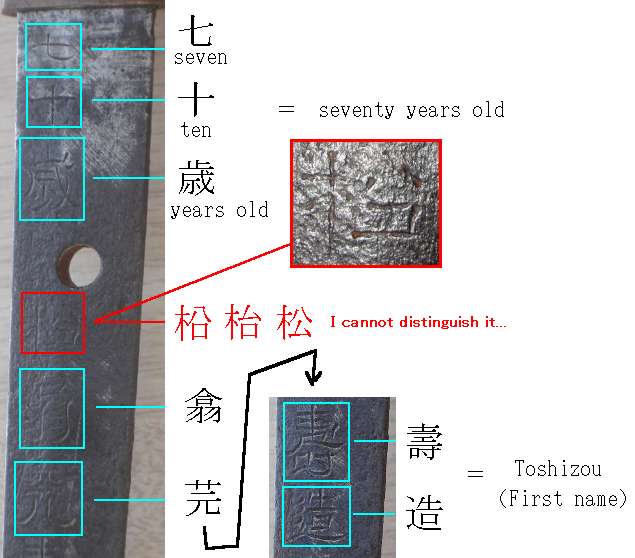
I'm interested in Medieval Arms and Armor.
But... My English is very poor ><;
|
|
  |
 |
Nathan Robinson
myArmoury Admin


|
|
    |
 |
|
Dan Bexell
|
 Posted: Fri 12 Nov, 2010 9:41 am Post subject: Posted: Fri 12 Nov, 2010 9:41 am Post subject: |
 |
|
|
Thank you for the translation. Your English is very good.
|
|
  |
 |
Etienne Hamel

Location: Granby (QC) canada Joined: 09 Sep 2006
Posts: 443
|
 Posted: Thu 09 Dec, 2010 1:04 pm Post subject: Posted: Thu 09 Dec, 2010 1:04 pm Post subject: |
 |
|
| Ushio Kawana wrote: | Hi 
John mailed some phtos to me.
And I was able to read the letters of the other side. 
It's mean "An August, 1849 excellent luck".
Kaei was a Japanese era name... http://en.wikipedia.org/wiki/Kaei
I was able to read the letters of the other side.
It's mean "Seventy years old (family name) Toshizou" The family name was not readable to me. 
These kanji is old kanji. So it is hard to distinguish it... 
It is written as "An August, 1849 excellent luck" on the front(back) side.
And it is written as "Seventy years old (family name) Toshizou" on the back(front) side.
This sword may be memory of the birthday. 
thanks  |
the only familly name that rings a bell with that first name is hijikata but i don't think it is what is engraved on that nakago... 
|
|
  |
 |
|
Harry J. Fletcher
|
 Posted: Thu 09 Dec, 2010 2:22 pm Post subject: Thank you Mr. Kawana Posted: Thu 09 Dec, 2010 2:22 pm Post subject: Thank you Mr. Kawana |
 |
|
This subject is fascinating and I want to thank Mr. Ushiro Kawana for his research and presentation. I have some Japanese character indexes in reference books but I run into problems of trying to find an exact match of the character on the nakago and the character in the index. It is fun looking at mei's in pictures of Japanese swords and trying to translate them by using the indexes I have. For those of us who don't speak or read Japanese and are interested in the collector's side of Japanese swords it is almost essential to know at least something about the mei even if it is rudimentary.
My first look at the mei revealed that there was no showa mark and knew it had to be an older sword and better quality blade than the usual mass production neogunto or gunto blades produced for the Japanese military. I would have liked to have seen pictures of the blade in order to look at the grain of the steel, or hada to see if there was a hamon and nioi or nie, leaving the translation of the mei until last.
This appears to have been a sword commissioned for the the birthday of some family member about twenty years before the Meiji restoration and therefore and hierloom.
Regards,
Harry
To Study The Edge of History
|
|
  |
 |
Etienne Hamel

Location: Granby (QC) canada Joined: 09 Sep 2006
Posts: 443
|
 Posted: Thu 09 Dec, 2010 2:46 pm Post subject: Posted: Thu 09 Dec, 2010 2:46 pm Post subject: |
 |
|
Am i the only one to see this??? on one of the picture i can clearly see the ''U'' like kanji and i see something in the ''U'' (sorry i don't know japanese) like a small bar...
http://www.myArmoury.com/talk/download.php?id=31632 take a look closely... it is light but i can see it... is there a kanji ressembling this?
|
|
  |
 |
|
Harry J. Fletcher
|
 Posted: Thu 09 Dec, 2010 5:34 pm Post subject: Etienne Posted: Thu 09 Dec, 2010 5:34 pm Post subject: Etienne |
 |
|
Yes, I see the U you refer to and a Japanese character in the space under the open end. I think the U is just a forging mark or gouge in the metal. After a closer examination of the photos what troubles me are the FILE MARKS WHICH LOOK RECENT and then the CHARACTERS OF THE MEI STAMPED ON TOP OF THEM! Although I am not saying the sword is fake or trying to cast doubt on the acquisition as stated I would have trouble accepting this sword as genuine. There are a lot of clever fakes coming out of China these days. If a Gunto or neogunto there should be arabic nuberic numerals on the blade near the mune adjacent to the habaki. the Showa mark could also have filed or rubbled off with a stone. One sure way to bring this out is electro magnetic particle testing which would show the original numerals and marks if any were there. Again, I am not saying this sword is a fake but would not say it is 100% authenic either and so I reserve my judgement with doubts.
To Study The Edge of History
|
|
  |
 |
Ushio Kawana

|
 Posted: Thu 09 Dec, 2010 6:34 pm Post subject: Posted: Thu 09 Dec, 2010 6:34 pm Post subject: |
 |
|
Hi Etienne Hamel and Harry J. Fletcher 
| Quote: | | the only familly name that rings a bell with that first name is hijikata but i don't think it is what is engraved on that nakago... |
Perhaps you mean "Hijikata Toshizou"
http://en.wikipedia.org/wiki/Hijikata_Toshiz%C5%8D
It is the same name, but spelling(Japanese kanji) is different.
| Quote: | | Am i the only one to see this??? on one of the picture i can clearly see the ''U'' like kanji and i see something in the ''U'' (sorry i don't know japanese) like a small bar... |
Perhaps "U" like kanji is...
Then it is written as "An August, 1849, excellent luck, 20 years old". 
There is not the conclusive evidence... This is my prediction...
 Attachment: 23.85 KB Attachment: 23.85 KB
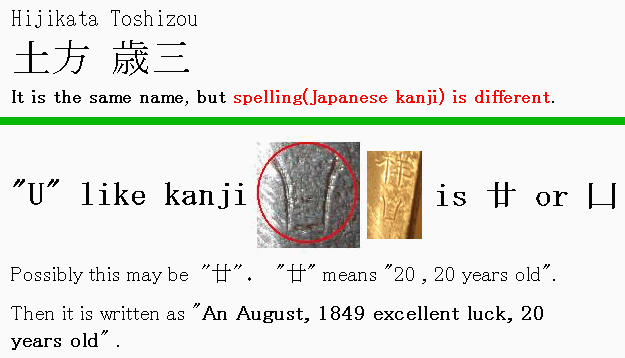
I'm interested in Medieval Arms and Armor.
But... My English is very poor ><;
|
|
  |
 |
Etienne Hamel

Location: Granby (QC) canada Joined: 09 Sep 2006
Posts: 443
|
 Posted: Thu 09 Dec, 2010 7:22 pm Post subject: Posted: Thu 09 Dec, 2010 7:22 pm Post subject: |
 |
|
now there is two options that comes to my mind... maybe the blade was made by a 20 years old man to offer as a gift to the 70 years old one OR the 70 years old one made the sword for the 20th birthday of the younger one... if that blade was for a soldier or a military man it would be plausible that the blade was made as a good luck gift for his military career... but it's only supposition 
sometimes i have too much imagination and it must be way off topic sorry guys 
|
|
  |
 |
|
Harry J. Fletcher
|
 Posted: Wed 15 Dec, 2010 1:36 pm Post subject: My translation so far Posted: Wed 15 Dec, 2010 1:36 pm Post subject: My translation so far |
 |
|
The first character is SHICHI or 7 and the second character is JU or 10. The third character of the mei has given some trouble and appears to be a composite. The basic character is GAN but it is composed of radicals for mountain, cliff, and dry (a) SAN or mountain (b) SEKI, SHAKU or stone, rock meaning boulder and cliff (c) KAN or dry. GAN is combined with SEI or become, make to from the composite character Ior authority, threaten which implies fearsome.
So this is what I have: SEVEN TEN FEARSOME AKI YOSKI SETTSU (province implied)... we have the character HACHI or 8 over GEN, GAN, MOTTO or origin or source.
So far we now have SEVEN TEN FEARSOME AKIYOSHI SETTSU EIGHT ORIGIN for the litteral translation. Akiyoshi was a swordsmith in Settsu province and was most prolific around 1860 with the value of his swords being given at 5 points each.
To Study The Edge of History
Last edited by Harry J. Fletcher on Thu 16 Dec, 2010 1:18 pm; edited 1 time in total
|
|
  |
 |
|
Harry J. Fletcher
|
 Posted: Wed 15 Dec, 2010 2:21 pm Post subject: Alternate interprotation Posted: Wed 15 Dec, 2010 2:21 pm Post subject: Alternate interprotation |
 |
|
I have just thought of an alternate interpretation for the characters for AKI and YOSHI. When use together they could form the thought KOKUMEI or diligence and that means Akiyoshi is out the window. Of course this is predicated on my guess for seeing the correct character strokes to begin with. Japanese idiographs are not easy even for Japanese who have the advantage of being exposed to them for a lifetime. Common characters, yes but over time meanings change and tend to shift.
To Study The Edge of History
|
|
  |
 |
Ushio Kawana

|
 Posted: Wed 15 Dec, 2010 8:44 pm Post subject: Posted: Wed 15 Dec, 2010 8:44 pm Post subject: |
 |
|
Sorry, I needs lots time to write a reply... Because I use the image for a reply...   
Please waite... a few days... 
Important: The "old kanji" is different from the "present kanji".
I'm interested in Medieval Arms and Armor.
But... My English is very poor ><;
|
|
  |
 |
Gottfried P. Doerler

|
 Posted: Thu 16 Dec, 2010 3:10 am Post subject: Posted: Thu 16 Dec, 2010 3:10 am Post subject: |
 |
|
hm. interesting.
allow me a different question meanwhile: why is there a circular hole in the blade ??
|
|
  |
 |
Luka Borscak

|
 Posted: Thu 16 Dec, 2010 3:32 am Post subject: Posted: Thu 16 Dec, 2010 3:32 am Post subject: |
 |
|
|
That is not a blade, that is a tang. Through that hole goes a stick for fixing tsuka (grip).
|
|
  |
 |
Eric S

|
 Posted: Thu 16 Dec, 2010 8:21 am Post subject: Posted: Thu 16 Dec, 2010 8:21 am Post subject: |
 |
|
| Luka Borscak wrote: | | That is not a blade, that is a tang. Through that hole goes a stick for fixing tsuka (grip). |
Thats not a hole its a mekugi-ana and its not a stick its a mekugi  A helpful guide Japanese sword terms. http://members.shaw.ca/nihontonut/glossary.html A helpful guide Japanese sword terms. http://members.shaw.ca/nihontonut/glossary.html
|
|
   |
 |
Gottfried P. Doerler

|
 Posted: Fri 17 Dec, 2010 1:43 am Post subject: Posted: Fri 17 Dec, 2010 1:43 am Post subject: |
 |
|
ah ok, i was so fixed on the letters, didn`t look closely enough.
but that brings up another problem - you won`t see the inscript, when the tsuka is fixed.
|
|
  |
 |
Eric S

|
 Posted: Fri 17 Dec, 2010 7:49 pm Post subject: Posted: Fri 17 Dec, 2010 7:49 pm Post subject: |
 |
|
| Gottfried P. Doerler wrote: | ah ok, i was so fixed on the letters, didn`t look closely enough.
but that brings up another problem - you won`t see the inscript, when the tsuka is fixed. |
On Japanese swords the handle "tuska" is removable for viewing of the signature "mei" on the tang "nakago" by pulling out the wooden pin "mekugi' that goes through the hole "mekugi ana" in both the nakago and tuska.
|
|
   |
 |
|
|

